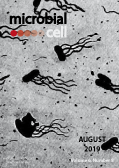Table of contents
Volume 6, Issue 8, pp. 324 - 372, August 2019
Cover: Image extracted from "Pathogenic micro-organisms. A text-book of microbiology for physicians and students of medicine. (Based upon Williams' Bacteriology)" (1920) by Ward J MacNeal and Herbert U. Williams and entitled "Bacillus coli showing flagella" (retrieved via flickr.com; contributing library: Cornell University Library; digitizing sponsor: MSN); the image was modified by MIC. The cover is published under the Creative Commons Attribution (CC BY) license.
Enlarge issue cover
Integrins in disguise – mechanosensors in Saccharomyces cerevisiae as functional integrin analogues
Tarek Elhasi and Anders Blomberg
Reviews |
page 335-355 | 10.15698/mic2019.08.686 | Full text | PDF |
Abstract
The ability to sense external mechanical stimuli is vital for all organisms. Integrins are transmembrane receptors that mediate bidirectional signalling between the extracellular matrix (ECM) and the cytoskeleton in animals. Thus, integrins can sense changes in ECM mechanics and can translate these into internal biochemical responses through different signalling pathways. In the model yeast species Saccharomyces cerevisiae there are no proteins with sequence similarity to mammalian integrins. However, we here emphasise that the WSC-type (Wsc1, Wsc2, and Wsc3) and the MID-type (Mid2 and Mtl1) mechanosensors in yeast act as partial functional integrin analogues. Various environmental cues recognised by these mechanosensors are transmitted by a conserved signal transduction cascade commonly referred to as the PKC1-SLT1 cell wall integrity (CWI) pathway. We exemplify the WSC- and MID-type mechanosensors functional analogy to integrins with a number of studies where they resemble the integrins in terms of both mechanistic and molecular features as well as in the overall phenotypic consequences of their activity. In addition, many important components in integrin-dependent signalling in humans are conserved in yeast; for example, Sla1 and Sla2 are homologous to different parts of human talin, and we propose that they together might be functionally similar to talin. We also propose that the yeast cell wall is a prominent cellular feature involved in sensing a number of external factors and subsequently activating different signalling pathways. In a hypothetical model, we propose that nutrient limitations modulate cell wall elasticity, which is sensed by the mechanosensors and results in filamentous growth. We believe that mechanosensing is a somewhat neglected aspect of yeast biology, and we argue that the physiological and molecular consequences of signal transduction initiated at the cell wall deserve more attention.
The influence of the microbiota on immune development, chronic inflammation, and cancer in the context of aging
Taylor N. Tibbs, Lacey R. Lopez and Janelle C. Arthur
Reviews |
page 324-334 | 10.15698/mic2019.08.685 | Full text | PDF |
Abstract
From birth, the microbiota plays an essential role in human development by educating host immune responses. Proper maturation of the immune system perturbs chronic inflammation and the pathogenesis of disease by preventing inappropriate immune responses. While many have detailed the roles of specific microbial groups in immune development and human disease, it remains to be elucidated how the microbiota influences the immune system during aging. Furthermore, it is not yet understood how age-related changes to the microbiota and immune system influence the development of age-related diseases. In this review, we outline the role of the microbiota in immune system development as well as functional changes that occur to immune cell populations during immunosenescence. In addition, we highlight how commensal microbes influence the pathogenesis of cancer, a prominent disease of aging. The information provided herein suggests that age-related changes to the microbiota and immune system should be considered in disease treatment and prevention strategies.
Network dynamics of the yeast methyltransferome
Guri Giaever, Elena Lissina and Corey Nislow
Research Articles |
page 356-369 | 10.15698/mic2019.08.687 | Full text | PDF |
Abstract
Sulfur assimilation and the biosynthesis of methionine, cysteine and S-adenosylmethionine (SAM) are critical to life. As a cofactor, SAM is required for the activity of most methyltransferases (MTases) and as such has broad impact on diverse cellular processes. Assigning function to MTases remains a challenge however, as many MTases are partially redundant, they often have multiple cellular roles and these activities can be condition-dependent. To address these challenges, we performed a systematic synthetic genetic analysis of all pairwise MTase double mutations in normal and stress conditions (16°C, 37°C, and LiCl) resulting in an unbiased comprehensive overview of the complexity and plasticity of the methyltransferome. Based on this network, we performed biochemical analysis of members of the histone H3K4 COMPASS complex and the phospholipid methyltransferase OPI3 to reveal a new role for a phospholipid methyltransferase in mediating histone methylation (H3K4) which underscores a potential link between lipid homeostasis and histone methylation. Our findings provide a valuable resource to study methyltransferase function, the dynamics of the methyltransferome, genetic crosstalk between biological processes and the dynamics of the methyltransferome in response to cellular stress.
Bacterial maze runners reveal hidden diversity in chemotactic performance
M. Mehdi Salek, Francesco Carrara, Vicente Fernandez and Roman Stocker
Microreviews |
page 370-372 | 10.15698/mic2019.08.688 | Full text | PDF |
Abstract
Chemotaxis allows microorganisms to exploit gradients in chemical stimuli to find nutrient resources and hosts or escape noxious substances. Thus, the life of individual microbes in their natural environments is a continual sequence of decisions based on the perceived chemical gradients. However, it has remained unclear to what extent the chemotaxis properties vary among cells of one species, and whether there is a spectrum of different ‘decision makers’ within populations of bacteria. In our recent study (Salek, Carrara et al., Nature Communications 10 (1), 1877), we combine microfluidic experiments with mathematical modeling to demonstrate that even in clonal populations, bacteria are individuals with different abilities to climb chemical gradients.










